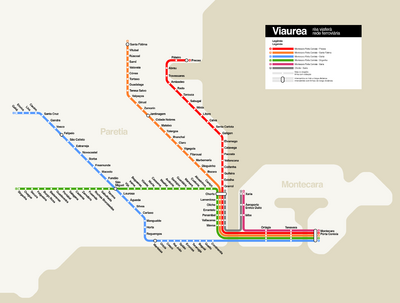Viaurea
 | |||
| Overview | |||
|---|---|---|---|
| Owner | VM | ||
| Area served | |||
| Transit type | Regional rail | ||
| Number of lines | 6 | ||
| Number of stations | 119 | ||
| Headquarters | Montecara | ||
| Website | viaurea | ||
| Operation | |||
| Reporting marks | VAA | ||
| Technical | |||
| System length | 378 km (235 mi) | ||
| Track gauge | 1,500 mm (4 ft 11 1⁄16 in) | ||
| Electrification | 25 kV / 50 Hz AC overhead lines | ||
| |||
Viaurea is a regional rail network connecting Montecara with destinations in the Paretian constitutent kingdom of Luzela. Operated as a division of VM, it receives additional subsidies from the Luzelan government.
Routes
The Viaurea network consists of six lines, five of which terminate at Montecara Pòrta Conìxia railway station. Lines A, B, C, D, and F travel through the Aurean Tunnel; line E operates entirely within Montecara.
| Line | Terminals | km | Stations | |
|---|---|---|---|---|
| Montecara Pòrta Conìxia | Precea | 117 | 31 | |
| Santa Fátima | 126 | 33 | ||
| Gahã | 149 | 36 | ||
| Sirganha | 134 | 40 | ||
| Xarìa | 50 | 6 | ||
| Chorto | Xarìa | 42 | 10 | |
Fare structure
Fares outside Montecara are fixed based on the distance traveled. Journeys within Montecara are part of the integrated VM fare structure. This is particularly useful for travel between Montecara-Enrico Dulio International Airport and the city center, as line E is effectively an express service that makes only three intermediate station stops between the airport and Montecara Pòrta Conìxia railway station.
Seating is divided into first- and second-class sections. First-class seating includes a surface suitable for a laptop and a dual power outlet along with a slightly larger seat that offers more legroom.
Rolling stock
All new rolling stock since 2003 has consisted of the Paretian-built CFP 460 series electric multiple unit. These trains can reach a maximum speed of 120 km/h and, depending on the specific model, have seating for up to 277 and a total capacity of up to 997. They offer the flexibility to operate with as few as two and as many as five cars. The older CFP 440 series units are all due to be phased out by the end of 2025. Moving toward a single train type significantly reduces maintenance costs and shortens time spent in the garage, as parts can be kept on hand and mechanics to not have to be trained across a wide variety of equipment.
| Image | Class | Built | Top speed | Formation | Capacity | Length | Width |
|---|---|---|---|---|---|---|---|

|
CFP Citat 460 series | 2003–present | 120 km/h | 3, 4, or 5 cars | 3 cars: 607 (169 seated) 4 cars: 832 (223 seated) 5 cars: 997 (277 seated) |
22.8 m (end cars) 17.7 m (intermediate cars) 63.3–98.7 m (overall) |
2.94 m |

|
CFP 440 series | 1993–2001 | 120 km/h | 3 cars (2 powered; 2 complete units can be combined) | 702 (234 seated) | 76 m | 2.90 m |
